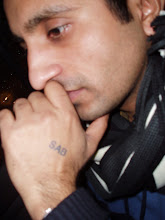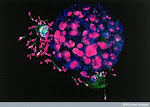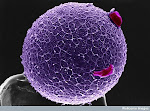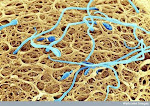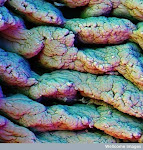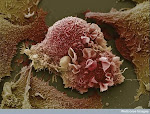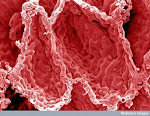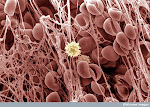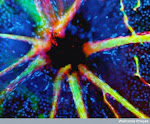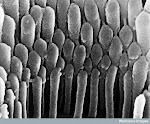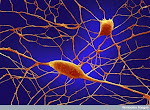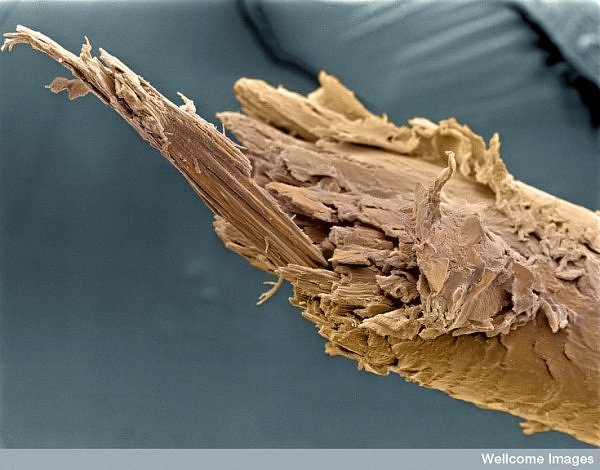Friday, October 30, 2009
भारतीय का कमाल, बनाया कैंसर रोधी डिश
भारतीय मूल के 32 वर्षीय शेफ गुरप्रीत बैंस का दावा है कि चिकन, ब्लूबेरी और गोजी बेरी से बनी यह सब्जी और पिलाऊ राइस [विशेष प्रकार के चावल] एक ऐसा स्वास्थ्यवर्धक भोजन है जो कैंसर और अल्झाइमर्स के खतरों को घटा देता है।
एक व्यक्ति को परोसे गए इस व्यंजन में पालक के 49 पत्तों और अंगूर के 23 गुच्छों और ब्रोकोली के एक डंठल के बराबर पौष्टिक तत्व पाए जाते हैं।
उन्होंने बताया, दरअसल मसालेदार भोजन कैंसरजनित कोशिकाओं से लड़ने में सहायक होते हैं, जबकि अदरक, मिर्च लहसुन और हल्दी जैसे मसालों में बैक्टीरिया व वायरस रोधी गुण पाए जाते हैं।
गुरप्रीत ने कहा, मेरे द्वारा बनाए गए व्यंजन में कई स्वास्थ्यवर्धक वस्तुओं का समागम है जिसके नियमित प्रयोग से आप बीमारियों से कोसों दूर रह सकते हैं।
गुरप्रीत आहार विशेषज्ञ भी रह चुके हैं। वह पिछले दो सालों से पोषक व्यंजन बनाने के नए-नए प्रयोगों में लगे हैं। इसमें प्रयुक्त ब्लूबेरी में प्रोटीन अधिक मात्रा में पाया जाता है जिससे दिमाग मजबूत होने के अलावा कैंसर का भी खतरा कम हो जाता है। पिलाऊ राइस में विटामिन ए और सी के अलावा आयरन भी प्रचुर मात्रा में होता है।
उन्होंने बताया कि इसमें चिकन का प्रयोग इसलिए किया जाता है क्योंकि इसमें वसा कम होने के अलावा यह काफी पोषक होता है।
Sunday, October 18, 2009
Smart bandage to help diabetics
Created for diabetics, the bandage would be studded with tiny sensors and send data to clinicians via the net.
Invented at the Diabetic Foot Clinic, in Aarhus, researchers believe it could help diabetics keep feet healthy and avoid the risks of amputation.
Diabetes can mean poor circulation and nerve damage so that even small cuts or blisters on feet can go unnoticed and develop into a serious ulcer.
Distant diagnosis
Diabetics are advised to check their feet daily and seek early medical attention if there are any signs of damage.
Without timely treatment and monitoring, patients with such ulcers may need to have their toes, feet or even their entire leg amputated.
With a mobile phone connected to the intelligent bandage, the patient could go on holiday to another continent and still be monitored
Dr Niels Ejskjaer
Following a foot injury two months ago, diabetic patient Paul Hansen has been forced to attend weekly check-ups at the Aarhus clinic, 60km away.
Dr Niels Ejskjaer, head of the Diabetic Foot Clinic, believes that an intelligent bandage would cut the need for such visits.
"Modern technologies should be able to help us monitor patients like Paul remotely, and let us know what his condition is without a hospital visit," he told the BBC's Go Digital.
"If sensors were built into the bandage that would mean we could have information about the wound as it heals," he said, "its temperature, humidity, and perhaps even the types of bacteria present."
"This would allow the bandage to stay on for much longer and would save on the cost of medical care by avoiding unnecessary hospital visits," said Dr Ejskjaer.
Medical data from the intelligent bandage could easily be sent to the clinic, via phone or the internet.
Advances in wireless technology would allow for medical check-ups from anywhere in the world.
"With a mobile phone connected to the intelligent bandage, the patient could go on holiday to another continent and still be monitored," Dr Ejskjaer said.
Remote Control
Currently the idea is at the concept stage.
Although researchers in Aarhus have connected temperature and humidity sensors to a computer chip, they are currently too large to be practical.
Doctor monitoring treatment remotely
Doctors could use portable devices to monitor treatment
But Dr Ejskjaer believes the intelligent bandage is an idea that is ripe for exploitation in the telemedicine systems of tomorrow.
Already, more conventional telemedicine projects are under evaluation in Aarhus.
These have attempted to replace hospital visits with remote check-ups from the patient's home, using digital cameras to capture pictures of their feet and phone or internet connections to transmit these to the clinic.
Local nurses must still visit patients, to supervise the process as well as remove and replace bandages.
But an intelligent bandage, if it could be developed successfully, would remove the need for home visits, though for now the prototype is missing an important component - a digital nose.
Whilst most of us try to avoid proximity with other people's smelly feet, for a diabetic foot doctor those cheesy odours speak volumes on the health of our soles.
"Without a smell detector in the intelligent bandage," said Dr Ejskjaer, "we might miss a developing infection, which could be an important hurdle to overcome in our particular branch of telemedicine."
Material sciences at its best...............
A team of scientists from Italy and Sweden has developed what is believed to be the first artificial hand that has feeling.
It has been attached to the arm of a 22-year-old man who lost his own hand through cancer.
Researchers say it works by connecting human nerve endings with tiny electronic sensors.
Wednesday, October 14, 2009
खून का रंग बता देगा क्या है रोग!
वे ऐसा मालीक्यूल बनाने में लगे हैं जो खून के बदलते रंगों की मदद से किसी भी मर्ज के चेहरे से गुमनामी का पर्दा चाक कर देगा। सरल शब्दों में 'ब्लड टेस्ट' की तमाम क्लीनिकल पेंचीदगियों के दिन अब लदने वाले हैं। खून अब रंगों की भाषा बोलेगा और गुमनामी के चलते असाध्य साबित होने वाले रोगों के राज भी आसानी से खोलेगा।
अगर वैज्ञानिकों को इस मुहिम में सफलता मिल गई तो इससे नि:संदेह स्वस्थ समाज के सरोकारों को नया आयाम तो मिलेगा ही विश्वविद्यालय की ख्याति और बुलंद होगी।
'हार्स रैडिस परास्किडेज, एंजाइम' विकसित करने में जुटे रसायन विभाग के प्रो. एमएस सिंह कहते हैं कि रोगों को जानने के लिए तमाम तरह के उपकरण तो विकसित हैं पर उनका यह शोध खून को केंद्र में रखकर किया जा रहा है।
वह ऐसा मालीक्यूल यानी किट बनाने में लगे हैं जिस पर खून की एक बूंद डालते ही किट का रंग बदलने लगेगा। यह बदलता रंग ही रोगों की पहचान का आधार होगा।
इसके सिद्धांतों से मिशिगन डायग्नोस्टिक लिमिडेट [अमेरिका] को अवगत कराया जा रहा है और वहीं इसका परीक्षण भी हो रहा है। बतातें हैं कि अमेरिका की इसी संस्था ने यह प्रोजेक्ट भी सौंपा है, शोध जारी है। खून के जरिए एड्स, डायबिटीज, टाइफाइड, जांडिस, किडनी आदि के रोगों की जानकारी होती है। अभी इन सभी की जांच के लिए अलग-अलग व्यवस्थाएं है।
इस किट के उपयोग से खून की थोड़ी सी मात्रा मात्र से ही विभिन्न रोगों की जानकारी हो सकेगी। केवल इतना ही नहीं इसके माध्यम से शरीर की आंतरिक संरचना की गतिविधियों के बारे में भी जाना जा सकता है।
Thursday, September 3, 2009
welldone doc: AIIMS docs successfully operate on 'miracle baby'
Thursday. In this path-breaking surgery, the doctors have created a new world record by doing the surgery without suspending his body functions.
"We decided to do the surgery without suspending his body functions. As there was no space in his body to accommodate the heart, we created a window between the chest and abdomen to place the heart. Then gradually rotated the heart and put it back in the newly created space," said Dr AK Bisoi, additional cardiothoracic surgeon, AIIMS, who led the team.
The baby has been shifted to Cardiac Care Unit and doctors say that every hour now is critical for the baby. "We have to closely monitor the baby. Every hour is crucial. We have to see how he responds to the surgery. Every stage was a challenge and the fact that he has survived for 10 days itself is an achievement," said Dr Bisoi.
But the biggest achievement for the doctors is that they could operate upon him on while his heart was beating. Initially, the doctors had planned that the baby will be put on a heart-and-lung machine and his body temperature would be lowered to 18 degree Celsius thereby suspending his body functions for a period of 30 minutes.
The surgery started at 9 am on Thursday and was completed in three-and-half-hours.
In India, this 10-day-old is the first baby to have survived this rare medical condition -- Ectopia Cordis -- for such a long period and to successfully survive the complicated surgery.
The baby was born with a rare medical condition called Ectopia Cordis. Worldwide, 230 such cases have been reported and only three people have survived this condition.
Sunday, August 2, 2009
Proud to be IITians
drought, flood, vegetation and forestation.
The satellite, designed and developed by a group of students of the institute, will be handed over to ISRO, which is expected to launch it by the end of the year.
"This satellite will have specific function of sending imagery on ground conditions. We will set up a tracking station in our institute where we will get the real-time data on drought, flood, vegetation and forestation," IIT Kanpur Director Prof S G Dhande said.
The satellite, costing Rs 2.5 crore, has been developed by a team of students led by Santanu Agrawal, an M Phil student.
The nanosatellite, which will be named 'Jugnu', will have a mass of less than 10 kg. It will piggyback on larger launches, avoiding the need for a dedicated launch.
"There will be no dedicated launch of this satellite. These kinds of satellites are launched from the belly of large satellites," Dhande said.
These nanosatellites have hardly any relation with nanotechnology. The nanosats, as they are called, are appealing because their small size makes them affordable and opens up potential for a swarm of satellites.
IIT Kanpur embarked on this innovative venture after the ISRO started accepting satellites developed by other countries and universities.
"We took it as a challenge. We thought why should not we develop a satellite and give it to ISRO. Then 20 students got inspired by the idea and started its designing and fabrication," Dhande said.
This satellite is not geosynchronous and will have low earth orbit. The data can be accessed when the satellite will be visible from the tracking station, Dhande said.
This initiative is part of the institute's Golden Jubilee celebration starting this month. The celebration will continue till December next year.
Dhande said nanosatellites are the new-age satellites prepared for specific purposes. While larger satellites weigh about one tonne, these smaller varieties weigh less than 10 kg and have smaller electronic components.
As of now, there is limited research in the area of nanosats. The space companies and institutes mainly focus their research on larger ones.
Thursday, July 23, 2009
How Nanotechnology given new dimension to Imaging...........
Almost all of the following images were captured using a scanning electron microscope,
Incredible details of 1 to 5nm (nanometer) in size can be detected
1. Red Blood Cells
They look like little cinnamon candies here, but they're actually the most common type of blood cell in the human body - red blood cells (RBCs). These biconcave-shaped cells have the tall task of carrying oxygen to our entire body; in women there are about 4 to 5 million RBCs per micro liter (cubic millimeter) of blood and about 5 to 6 million in men. People who live at higher altitudes have even more RBCs because of the low oxygen levels in their environment.
2. Split End of Human Hair
Regular trimmings to your hair and good conditioner should help to prevent this unsightly picture of a split end of a human hair.
3. Purkinje Neurons
Of the 100 billion neurons in your brain. Purkinje (pronounced purr-kin-jee) neurons are some of the largest. Among other things, these cells are the masters of motor coordination in the cerebellar cortex. Toxic exposure such as alcohol and lithium, autoimmune diseases, genetic mutations including autism and neurodegenerative diseases can negatively affect human Purkinje cells.
4. Hair Cell in the Ear
Here's what it looks like to see a close-up of human hair cell stereo cilia inside the ear. These detect mechanical movement in response to sound vibrations.
5. Blood Vessels Emerging from the Optic Nerve
In this image, stained retinal blood vessels are shown to emerge from the black-colored optic disc. The optic disc is a blind spot because no light receptor cells are present in this area of the retina where the optic nerve and retinal blood vessels leave the back of the eye.
6. Tongue with Taste Bud
This colour-enhanced image depicts a taste bud on the tongue. The human tongue has about 10,000 taste buds that are involved with detecting salty, sour, bitter, sweet and savory taste perceptions.
7. Tooth Plaque
Brush your teeth often because this is what the surface of a tooth with a form of “corn-on-the-cob� plaque looks like.
8. Blood Clot
Remember that picture of the nice, uniform shapes of red blood cells you just looked at? Well, here's what it looks like when those same cells get caught up in the sticky web of a blood clot. The cell in the middle is a white blood cell.
9. Alveoli in the Lung
This is what a colour-enhanced image of the inner surface of your lung looks like. The hollow cavities are alveoli; this is where gas exchange occurs with the blood.
10. Lung Cancer Cells
This image of warped lung cancer cells is in stark contrast to the healthy lung in the previous picture.
11. Villi of Small Intestine
Villi in the small intestine increase the surface area of the gut, which helps in the absorption of food. Look closely and you will see some food stuck in one of the crevices.
12. Human Egg with Coronal Cells
This image is of a purple, colour-enhanced human egg sitting on a pin. The egg is coated with the zona pellicuda, a glycoprotein that protects the egg but also helps to trap and bind sperm. Two coronal cells are attached to the zona pellicuda.
13. Sperm on the Surface of a Human Egg
Here's a close-up of a number of sperm trying to fertilize an egg.
14. Human Embryo and Sperm
It looks like the world at war, but it is actually five days after the fertilisation of an egg, with some remaining sperm cells still sticking around. This fluorescent image was captured using a confocal microscope. The embryo and sperm cell nuclei are stained purple while sperm tails are green. The blue areas are gap junctions, which form connections between the cells.
15. Colored Image of a 6 day old Human Embryo Implanting
Friday, July 17, 2009
First Bilaterla hand Transplant
UNIVERSITY OF PITTSBURGH
MEDICAL CENTER
Jeff's Team: (l to r) SaraBeth Probst, Program Coordinator;
Dr. W.P. Andrew Lee, Primary Doctor and Investigator; Jeff Kepner; Dr. Gerald Brandacher, Co-Investigator, and Dr. Vijay Gorantla, Co-Investigator.
Jeff talks with SaraBeth during one of our visits to UPMC.
Jeff undergoing the Leukapheresis. This is a 3 hour process where the white blood cells are removed from the blood and frozen. They will be used during the transplant surgery if needed.

Jeff signs his paperwork officially placing him in the UPMC's Hand Transplant Clinical Trial Program on January 20, 2009.

On May 4, 2009, Jeff became the first Bi-Lateral Hand Transplant Recipient at the University of Pittsburgh Medical Center.
Life when you are a briliant scholar and spending life in EU (specially in Italy, w/o your wife or GF)
I am running on comptettion to my gf that who is the winner in spat, well seems i am the loosers as sometimes i wana call her but MCP prevents. But i love her a lot and rt now after drinking 3 1 ltr Heniken, i am missing her terrribly and trying to relax myself with BBC Odd Box that is fantastic stuff...........have a look (sorry for previous mistakes in the text)
http://news.bbc.co.uk/newsbeat/hi/newsbeat/newsid_8154000/8154951.stm
Love you Draling, missing you a lot
Wednesday, July 15, 2009
Piggy bank Transplant

एक जान और दो दिल। एक धड़कता और दूसरा नहीं। जीने के लिए भगवान ने तो एक दिल दिया था, पर अनफारचुनेटली वह जिंदगी की जंग जीतने में फेल्योर हो गया। तभी भगवान ने शायद एक डोनर का रुप धरकर उसे अपना इकलौता हार्ट देकर नई जिंदगी का अहसास कराया। तभी तो उसके एक शरीर में दो दिल बसते हैं।
निश्चित तौर पर यह वाक्या आपने पहले कभी नहीं सुना होगा। ये आश्चर्यजनक पर सच है। दस साल से भी ज्यादा बीत गए। ब्रिटेन में रहने वाली लड़की हनाह क्लार्क जिसकी उम्र महज दो साल होगी, उसके हार्ट ने काम करना बंद कर दिया। पैरेंट्स के पास केवल दवा और दुआ करने के अलावा कोई चारा नहीं था। एक समय ऐसा आया कि दवा ने भी काम करना बंद कर दिया। तब उन्होंने ब्रिटेन के एक जाने-माने डॉक्टर के सामने अपनी यह समस्या रखी। इसके बाद तो डॉक्टर ने जो उस मासूम सी बच्ची को ट्रीटमेंट दिया वो किसी चमत्कार से कम नहीं था। उस ट्रीटमेंट का नाम पिगी बैक ट्रांसप्लांट है। आज उस लड़की की उम्र 16 साल हो गई है. वह फ्री होकर ही नहीं सामान्य लड़कियों की तरह जिंदगी जी रही है।
लाइफ सेविंग ऑपरेशन
दरअसल डॉक्टर ने उसका लाइफ सेविंग ट्रांसप्लांट ऑपरेशन कर उसे नया हार्ट लगा दिया। यह वही हार्ट था जो किसी बेबी डोनर ने डोनेट किया था, हालांकि यह एक रिस्की गैंबल था, फिर भी उसके पैरेंट्स और डॉक्टरों ने यह गेम खेला। दो साल की हनाह क्लार्क को कार्डियोमायोपैथी नाम की डीसिज थी, इसमें ऑलमोस्ट हार्ट का साइज बड़ा हो जाता है और वह काम करना बंद कर देता है। ऑपरेशन के तहत डॉक्टरों ने एक पांच महीने की बच्ची का डोनेटेड हार्ट को हनाह के हार्ट के साथ ट्रांसप्लांट कर दिया। इस ट्रांसप्लांट के कारण उसे महीने में कई बार हॉस्पिटलाइज होना पड़ता था, 17 ड्रग्स लेनी पड़ती थी और साइड इफेक्ट के तौर पर पूरी बॉडी को इंफेक्शन से बचाना पड़ता था। ये दवाएं इसलिए कि उसका इम्यून सिस्टम लो होता जा रहा था. इसलिए दवाएं उसके इम्यून सिस्टम को हेल्दी बनाने और कामगार थी।
..जब धड़का दिल
ऑपरेशन हुए एक अरसा बीत गया। तभी एक दिन अचानक हना के ओरीजिनल हार्ट ने धड़कना शुरू कर दिया. डॉक्टरों ने इसे भी किसी चमत्कार से कम नहीं माना। यानी अब डॉक्टर भी मानते हैं कि दवा से ज्यादा दुआ काम आती है। फाइनली अब हनाह पूरी तरह से रिकवर हो गई है। वह दवाओं से ही नहीं बल्कि ट्रांसप्लांट ड्रग्स, रेग्यूलर हॉस्पिटल ट्रिप्स और लाइफ थ्रेटिंग इंफेक्शन से बरी हो चुकी है। जब इस बारे में हनाह के पैरेंट्स से प्रतिक्रिया जाननी चाही तो उन्होंने कहा कि उसकी हर सुबह स्माइल के साथ शुरू होती है। कल क्या होगा, किसने देखा. हम तो आज में जीते हैं. गॉड और गॉड रुपी डॉक्टर का थैंक्स है। यह लाइफ सेविंग प्रॉसेस का कॉन्सेप्ट अभी केवल ब्रिटेन में है। इसके लिए भी यह पायोनियर हार्ट स्पेशलिस्ट प्रोफेसर सर मैगदी याकूब द्वारा ही किया जाता है। कार्डियोमायोपैथी जैसी खतरनाक डीसिज एक लाख में एक बच्चे को होती है।
क्या है पिगी बैक
यह एक ऐसा ऑर्गन है जो नॉनफंक्शनल हार्ट के साथ कनेक्ट कर दिया जाता है। इससे ओरिजनल हार्ट फंक्शन करने लगता है मगर स्लो प्रेशर पर. इस ऑर्गन की कुछ सेल्स लंग्स से भी जोड़ दी जाती है ताकि लंग्स की वर्किंग बनी रहे। साथ ही डोनर हार्ट ब्लड की पंपिंग पूरी बॉडी में करता है जब नेचुरल हार्ट रेस्ट करता है। इसे हार्ट के चार अलग-अलग भाग में लगाया जाता है। यह कार्डियोमायोपैथी नाम की डीसिज के होने पर यूज किया जाता है.

